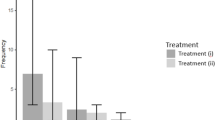Abstract
Some species of stalk-eyed flies (Diopsidae, Diptera) have a sexual dimorphism of eyespan. For example, Cyrtodiopsis whitei males have much longer eyestalks than females of equal body length. Expression of this trait increases with the bearers' size. The slope of the log-log regression line eyespan versus body length is close to two in males, while in females it is roughly one. Behavioural experiments suggest that male eyespan signals quantitatively a male's strength or attractiveness to a competitor or mate. We used 3 pure strains of C. Whitei, which were distinguished by their different phosphoglucomutase allele outfit. We compared the reproductive success of males of different sizes and found the number of offspring to be directly proportional to body length. Thus eyespan, rising with the square of body length, provides an exaggerated and highly conclusive signal in the advertisement of fitness.
Similar content being viewed by others
References
Blum S, Blum A (eds) (1975) Sexual selection and reproductive competition in insects. Acad Press, London
Burkhardt D, Motte I de la (1983) How stalk-eyed flies eye stalkeyed flies: Observations and measurements of the eyes of Cyrtodiopsis whitei (Diopsidae, Diptera). J Comp Physiol 151:407–421
Burkhardt D, Motte I de la (1985) Selective pressures, variability, and sexual dimorphism in stalk-eyed flies (Diopsidae). Naturwissenschaften 72:204–206
Burkhardt D, Motte I de la (1987) Physiological, behavioural, and morphometric data elucidate the evolutive significance of stalked eyes in Diopsidae (Diptera). Entomol Gen 12:221–233
Burkhardt D, Motte I de la (1988) Big ‘antlers’ are favoured: Female choice in stalk-eyed flies (Diptera, Insecta), field collected harems and laboratory experiments. J Comp Physiol A 162:649–652
Burkhardt D, Motte I de la (1993) Stalk-eyed flies: ‘caprices of evolution’ ? Proc Conference: Tropical Rainforest Res: Current Issues, Bandar Seri Begawan, Brunei, April 1993
Burkhardt D, Darnhofer-Demar B, Fischer K (1973) Zum binokularen Entfernungssehen der Insekten. 1. Die Struktur des Sehraumes von Synsekten. J Comp Physiol 87:165–188
Burkhardt D, Motte I de la, Yong HS (1991) PGM: A suitable genetic marker in studying mating success of Cyrtodiopsis whitei. Naturwissenschaften 78:76–78
Burla H (1990) Lek behavior in hypercephalic Zygothrica dispar Wiedemann (Diptera, Drosophilidae). Z Zool Syst Evolutionsforsch 28:69–77
Feijen H (1989) Diopsidae. In: Griffiths GCD (ed) Flies of the Nearctic Region, Vol IX Part 12, Schweizerbart, Stuttgart, pp 1–122
Fisher R (1958) The genetical theorie of natural selection. 2nd ed. Dover, New York
Grafen A (1990a) Sexual selection unhandicapped by the Fisher process. J Theor Biol 144:473–516
Grafen A (1990b) Biological signals as handicaps. J Theor Biol 144:517–546
Green AJ (1992) Positive allometry is likely with mate choice, competitive display and other functions. Anim Behav 43:170–172
Grimaldi G, Fenster G (1989) Evolution of extreme sexual dimorphism: Structural and behavioral convergence among broad-headed male Drosophilidae (Diptera). Am Mus Nov No 2939:1–25
Kotrba M (1993) Das Reproduktionssystem von Cyrtodiopsis whitei Curran (Diopsidae, Diptera) unter besonderer Berücksichtigung der inneren weiblichen Geschlechtsorgane. Bonn Zool Monograph No 33:1–115
Lorch PD, Wilkinson GS, Reillo PR (1993) Copulation duration and sperm precedence in the stalk-eyed fly Cyrtodiopsis whitei (Diptera, Diopsidae). Behav Ecol Sociobiol 32:303–311
Maynard Smith J (1985) Sexual selection, handicaps and true fitness. J Theor Biol 115:1–8
McAlpine DK (1979) Agonistic behavior in Achias austrails (Diptera, Platystomatidae) and the significance of eyestalks. In: Otte D, Alexander RD (eds) Sexual selection and reproductive competition in insects. Acad Press, London New York, pp 221–230
Merk W (1992) Der Kommentkampf der Stielaugenfliege Cyrtodiopsis whitei Curran (Diptera, Diopsidae) Thesis, University of Regensburg
Motte I de la, Burkhardt D (1983) Portrait of an Asian stalk-eyed fly. Naturwissenschaften 70:451–461
Petrie M (1992) Are all secondary sexual display structures positively allometric and, if so, why? Anim Behav 43:173–175
Shillito JF (1971) Dimorphism in flies with stalked eyes. Zool J Linn Soc 50:297–305
Steyskal GC (1972) A catalogue of species and key to the genera of the family of Diopsidae. Stuttgarter Beitr Naturkd No 234:1–20
Tan KB (1965) The taxonomy, biology, ecology, and behaviour of some Malayan Diopsidae. Thesis, University of Malaya, Kuala Lumpur
Thornhill R, Alcock J (1983) The evolution of insect mating systems. Harvard Univ Press, Cambridge Mass.
Yong HS, Sarjan R, Ooi PCA (1987) Allozyme variation in the cocoa pod borer, Conopomorpha cramerella (Lepidoptera: Gracillariidae), from different host plants. Malaysian J Sci 9:17–31
Author information
Authors and Affiliations
Rights and permissions
About this article
Cite this article
Burkhardt, D., de la Motte, I. & Lunau, K. Signalling fitness: larger males sire more offspring. Studies of the stalk-eyed fly Cyrtodiopsis whitei (Diopsidae, Diptera). J Comp Physiol A 174, 61–64 (1994). https://doi.org/10.1007/BF00192006
Accepted:
Issue Date:
DOI: https://doi.org/10.1007/BF00192006




